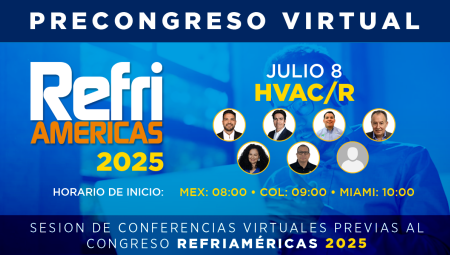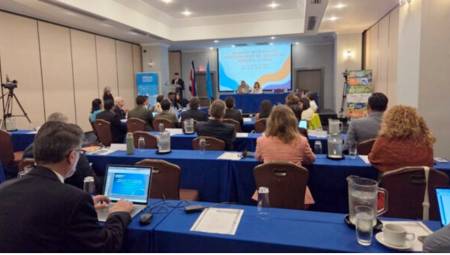The moment of truth
An industry that breathes optimism
The alliances that serve
Latino HVAC/R Association Are we ready?
 Almost all the industrial sectors that I have been able to know have a Latin American association. I am surprised, in a way, that ours being one of the oldest segments of engineering we do not have a fully identified association in the region that protects and defends the interests of professionals related to the CVAC / R.
Almost all the industrial sectors that I have been able to know have a Latin American association. I am surprised, in a way, that ours being one of the oldest segments of engineering we do not have a fully identified association in the region that protects and defends the interests of professionals related to the CVAC / R.But before we say that the idea is good or that you had already thought about it - which it very surely is - the truth is that we must stop to think about what the function of an entity of this type should be. The question arises because in many cases these organizations can end up becoming entities without a clearly defined north and in which adaptation to the new times is an almost impossible task.
I believe that Latin America, from Mexico to Argentina, has very solid companies in the distribution sector, representation, but also in installation and consulting. This is quite positive because it gives us to understand that we already have the most important asset: the raw material, which is people, with experience and good reputation.
In the region we have very important initiatives in the local and regional order. FAIAR, in the Ibero-American context, is an example of something that can be consolidated, all hand in hand with the interest that an entity like ASHRAE has been showing in Latin America.
One of the most important functions that such an entity can perform is to become the political voice of this sector. It is nice to see the strength with which the AHRI (Air Conditioning, Heating and Refrigeration Institute) comes out in defense when any of its members may be harmed by any regulation. Such an institution has even gone all the way to the United States Congress itself to lobby to stop some initiative harmful to the industry. The above, however, does not mean leaving aside the training, which has been the flag of the unions in Latin America.
With this we end for the moment dear readers. It was nothing more than an invitation to explore the possibility of having a pan-regional body that would help from another perspective with the improvement in the practices of the CVAC/R sector. I think we are on time.
A cold greeting.
More Articles …

HVAC project at the Javeriana University, finalist in the CALA Awards 2025 in the HVAC category
The HVAC system installed in the building of the Faculty of Sciences of the Pontificia Universidad Javeriana, in Bogotá, was selected as a finalist in the HVAC category of the CALA Awards 2025....

Concord Project in La Lima Free Trade Zone, finalist in the HVAC category of the CALA Awards 2025
The HVAC system project carried out by MultiFRIO for the company Concord in the La Lima Free Trade Zone, in Cartago, received the final prize in the HVAC category of the CALA Awards 2025, a...

HVAC project at the Universidad Santiago de Cali, finalist in the CALA AWARDS HVAC category
The air conditioning project of the Auditorium Building and the Technology Center of the new campus of the Santiago de Cali University was chosen as a finalist in the HVAC category of the CALA...

Carrier Launches Cold Climate Heat Pump with Maximum Efficiency and Low Noise
International. Carrier, a company belonging to Carrier Global Corporation, presented significant improvements in its heat pump technology designed for cold climates.

Expert Forum to Address Energy Efficiency and 4.0 Technologies in HVAC&R Systems
Colombia. On July 10, 2025, the specialized forum "Towards Energy Excellence in HVAC&R: ISO 50001, Technologies 4.0 and RETSIT" will be held, a space that will bring together experts and...

LG Electronics attributes lower-than-expected results to U.S. tariffs and market slowdown
International. LG Electronics reported a preliminary operating profit of approximately $460 million for the second quarter of the year, a figure that not only disappointed the market, but...

Hisense highlights air conditioning innovation during the 2025 FIFA Club World Cup
United States. Hisense is creating unforgettable moments for fans during the 2025™ FIFA Club World Cup with its global "Own the Moment" campaign.

AFEC renews its Board of Directors and updates its statutes at its 2025 General Assembly
International. The meeting brought together 130 professionals from the HVAC sector in Girona to review results, redefine structures and project the future of air conditioning in Spain.

Technology, efficiency and innovation at the Virtual HVAC Pre-Congress 2025
International. As a prelude to the Refriaméricas 2025Academic Congress, the Virtual HVAC Pre-Congress will be held on July 8, a free technical conference that will bring together experts and leading...

Chile leads with a gender focus in regional meeting on the Montreal Protocol
Costa Rica. Within the framework of the Meeting of Networks of National Ozone Officers of Latin America, held from June 17 to 19 and organized by the United Nations Environment Program, Chile stood...



